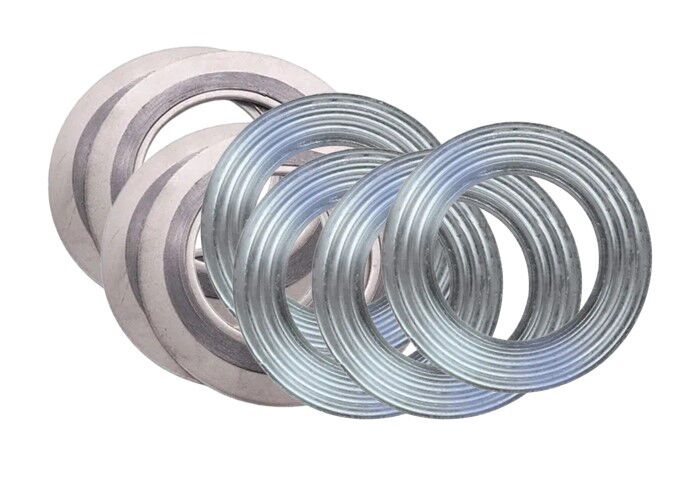
The Stainless Steel 316L/Flexible Graphite Composite Gasket is a high-performance sealing solution designed to combine the excellent compressibility and sealing characteristics of flexible graphite with the durability and rebound strength of a metal corrugated core. Through a specialized manufacturing process, the gasket integrates a corrugated 316L stainless steel framework with layers of flexible graphite, forming a composite structure that enhances both mechanical resilience and tightness under varying pressures. This performance test aims to evaluate key parameters such as compression, rebound, and leakage behavior under different sealing specific pressures, while also examining the effects of varying graphite layer thicknesses. The results offer insight into how design choices impact the gasket's ability to maintain integrity and sealing performance in demanding industrial applications.
The metal corrugated enhanced flexible graphite composite gasket (hereinafter referred to as the "graphite composite gasket") is a composite gasket made of corrugated framework and flexible graphite through a special process. The type of gasket is shown in Figure 1.1, where the uniformity and integrity of the corrugated framework and flexible graphite are strictly controlled. This composite gasket ensures the excellent sealing performance of flexible graphite and the good rebound characteristics of the metal corrugated plate. The product size of the test is shown in Figure 1.1
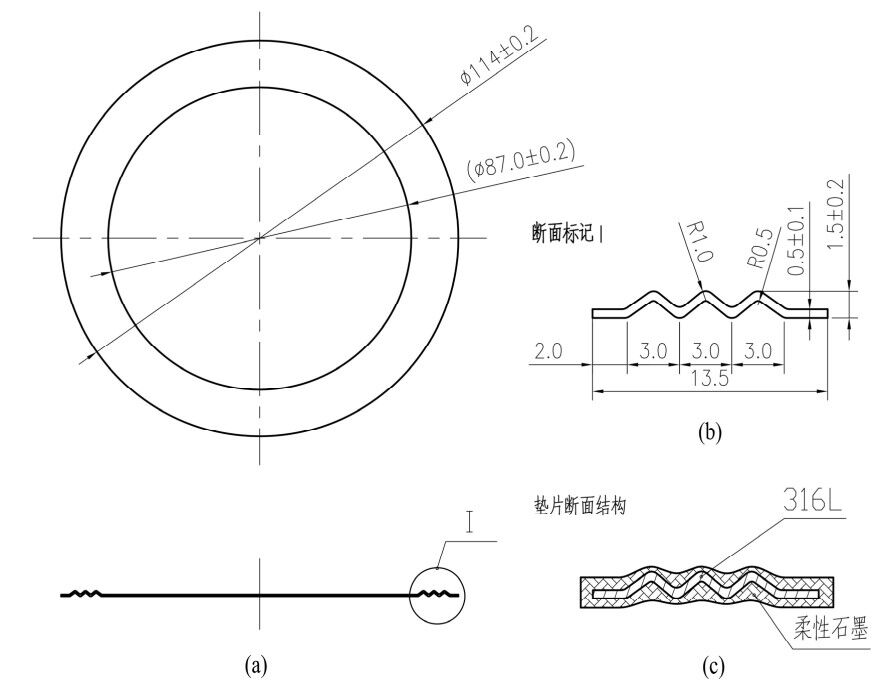
Figure 1.1: Composite Gasket Size and Structure (Graphite Thickness: d=0.6mm)
Figure 1.2 shows the stress-strain curves of the graphite composite gasket under different sealing specific pressures. It can be seen from the figure that the stress-strain curves of the gasket during the compression process have good repeatability, and the stress-strain under different specific pressures can be roughly divided into three stages, namely: slow rise (Stage A), fluctuation (Stage B), and rapid rise (Stage C), as shown in Figure 1.2. For Stage A, the flexible graphite covering the metal corrugated plate mainly bears the load, so the strain increases rapidly with the increase of stress, and the curve rises relatively gently; for Stage B, the curve fluctuates significantly and the differences under different specific pressures are significant. This is because in this stage, the flexible graphite layer has gradually filled the grooves of the metal corrugated plate, and the flexible graphite above the wave crest is gradually pushed to the sides, so the stress-strain curve fluctuates irregularly; when entering Stage C, the grooves of the metal corrugated plate have been completely filled with flexible graphite and the graphite above the wave crest has also been gradually compacted, and the enhancing effect of the metal corrugated plate gradually appears, so the stress-strain curve rises rapidly.
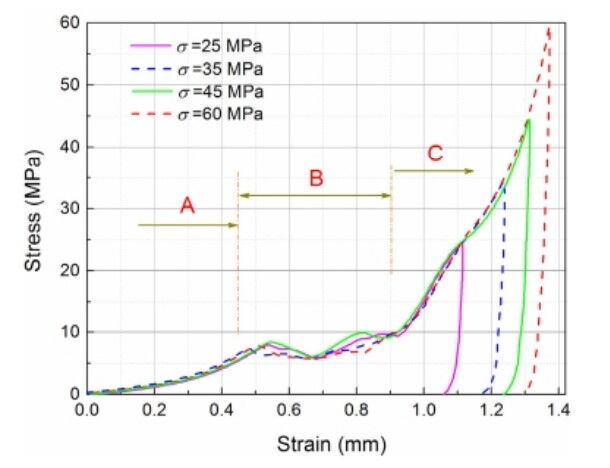
Figure 1.2: Stress-Strain Curves of Graphite Composite Gasket under Different Sealing Specific Pressures (Graphite Thickness: d=0.6mm)
Figure 1.3 shows the stress-strain curves of composite gaskets with different graphite layer thicknesses. It can be seen from the figure that the stress-strain curve of the metal corrugated gasket without flexible graphite cover does not have the Stage B in Figure 1.2. In addition, under two different gasket specific pressures, the corrugated gasket with 0.8 mm thick graphite cover layer has the longest duration of Stage B, indicating that when the graphite cover layer is 0.8 mm thick, the time for the graphite cover layer above the corrugated groove to be pushed to the sides and coordinated is longer.
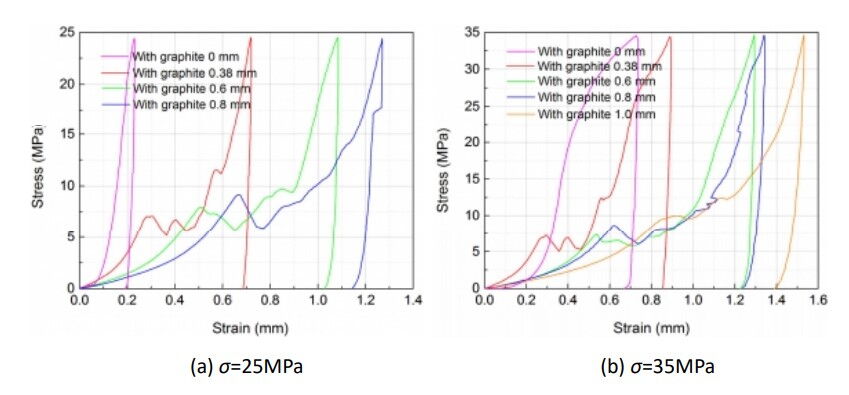
Figure 1.3: Stress-Strain Curves of Composite Gaskets with Different Graphite Thicknesses
Figure 1.4 shows the variation of the compression rate of composite gaskets with different graphite thicknesses with the change of gasket sealing specific pressure. It can be seen from the figure that with the increase of gasket sealing specific pressure, the compression rate of the gasket gradually increases and tends to be gentle. In addition, the compression rate of the graphite corrugated gasket without cover layer is significantly different from that of the gasket with graphite cover. Under a sealing specific pressure of 25MPa, the compression rate of the graphite corrugated gasket without cover layer is only about 15%, which is much lower than that of the gasket with graphite layer. However, when the sealing specific pressure increases to 35MPa, the compression rate exceeds that of the gasket with graphite layer.
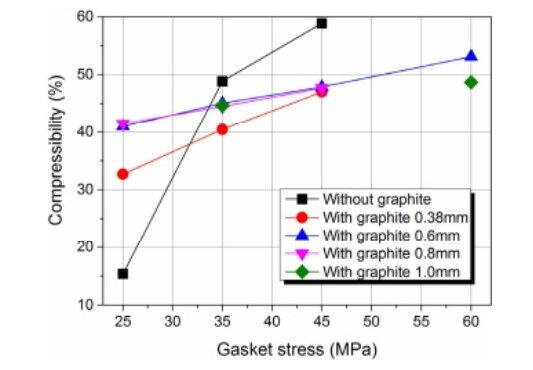
Figure 1.4: Variation of Compression Rate of Composite Gaskets with Different Graphite Thicknesses with Sealing Specific Pressure
By observing the morphology of the gasket after compression, it was found that the metal corrugation of the former was intact, and the residual height d of the gasket after compression/rebound test was still 1.36mm [see Figure 1.5(a)]; while after the sealing specific pressure exceeded 35MPa, the corrugation of the metal corrugated plate without graphite cover was almost flattened, and the residual height d of the gasket after compression/rebound test was less than 1.00mm [see Figure 1.5(b) and (c)]; however, the metal corrugated plate with graphite cover could still withstand a sealing specific pressure of 60MPa, and the corrugation was still relatively intact. For example, the residual height of the framework material (316L corrugated plate) of the composite gasket with 0.6mm graphite layer thickness was 1.16mm after compression/rebound at 60MPa [see Figure 1.6(a)]; while the residual height of the composite gasket with 1.0mm graphite layer thickness was still 1.41mm, and almost no plastic deformation occurred [see Figure 1.6(b)]. Therefore, the existence of the graphite layer can effectively resist the deformation of the framework material, enabling the gasket to withstand higher sealing specific pressures.
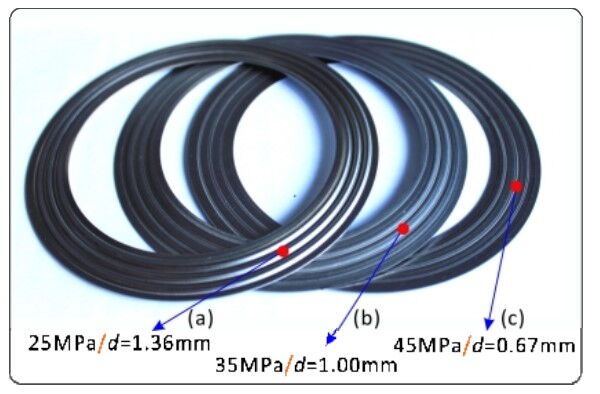
Figure 1.5: Morphology and Residual Thickness of 316L Framework Material (without Graphite Cover) after Compression/Rebound Test
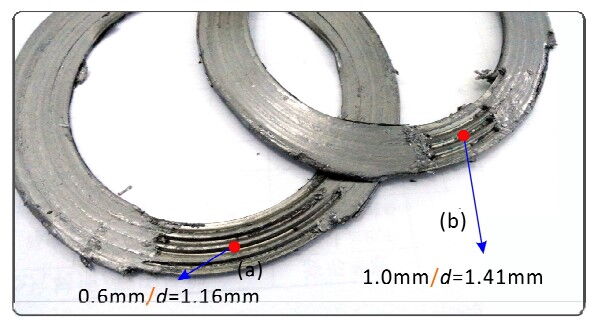
Figure 1.6: Morphology and Residual Thickness of Composite Gaskets with Different Graphite Thicknesses after 60MPa Compression/Rebound Test: (a) Graphite Layer Thickness 0.6mm; (b) Graphite Layer Thickness 1.0mm
The rebound rate of the gasket has an important impact on the sealing performance of the gasket. Figure 1.7 shows the variation of the rebound rate of composite gaskets with different graphite thicknesses with the change of gasket sealing specific pressure. It can be seen from the figure that on the one hand, with the increase of sealing specific pressure, the rebound rate of the gasket with graphite cover layer shows a slow downward trend, and the framework material without graphite cover layer shows a rapid downward trend in rebound rate due to serious plastic deformation under higher gasket stress; on the other hand, with the increase of graphite cover layer thickness, the rebound rate shows an upward trend, indicating that increasing the thickness of the graphite cover layer can improve the rebound rate of the composite gasket. The larger the rebound rate of the gasket, the more effectively it can compensate for the separation of the sealing surface caused by medium pressure, temperature, and flange load, ensuring the tightness of the connection system.
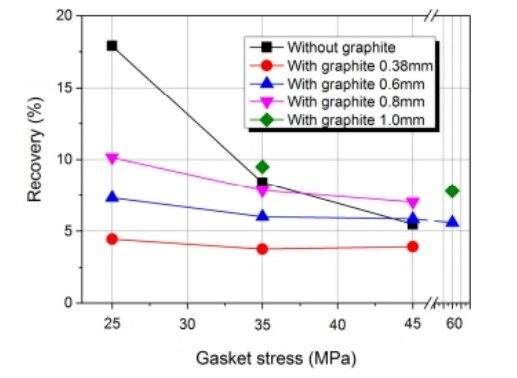
Figure 1.7: Variation of Rebound Rate of Composite Gaskets with Different Graphite Thicknesses with Gasket Stress
Figure 1.8 shows the variation of the absolute rebound amount of composite gaskets with different graphite thicknesses under a sealing specific pressure of 35MPa. It can be seen from the figure that with the increase of graphite cover layer thickness, the absolute rebound amount shows an upward trend; while the absolute rebound amount of the framework material without graphite cover layer is between the composite gaskets with graphite layer thickness of 0.38mm and 0.6mm.
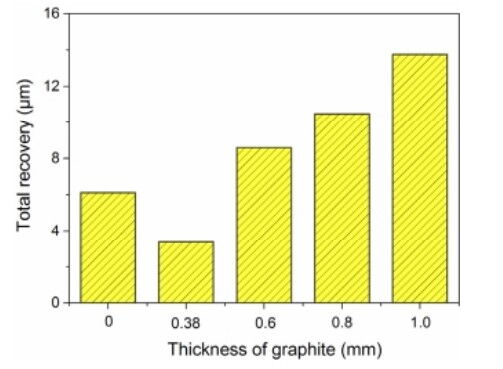
Figure 1.8: Effect of Graphite Thickness on Absolute Rebound Amount: Sealing Specific Pressure 35MPa
Figure 1.9 shows the variation of the absolute rebound amount of composite gaskets with different graphite cover layer thicknesses (0.38mm/0.6mm/0.8mm) with the change of gasket sealing specific pressure. It can be seen from the figure that the absolute rebound amount of composite gaskets with graphite cover layer thickness of 0.38mm and 0.6mm shows an upward trend with the increase of sealing specific pressure; the absolute rebound amount of composite gaskets with graphite cover layer thickness of 0.8mm shows a downward trend with the increase of sealing specific pressure; the common point is that with the increase of sealing specific pressure, the absolute rebound amount gradually tends to be stable. On the other hand, with the increase of graphite layer thickness, more graphite is piled up above the wave crest of the corrugated plate, and this part of graphite may have better rebound ability than the compacted graphite/corrugated plate under lower sealing specific pressure, so the absolute rebound amount of composite gaskets with graphite cover layer thickness of 0.8mm shows a downward trend with the increase of sealing specific pressure.
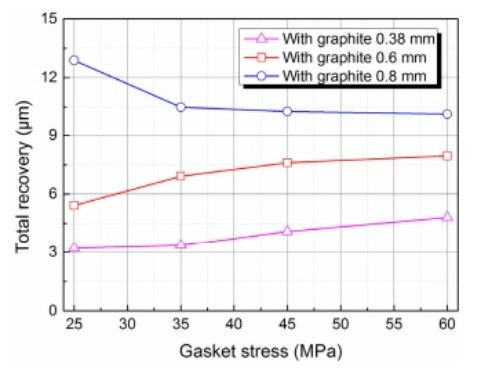
Figure 1.9: Effect of Gasket Stress on Absolute Rebound Amount
Figure 1.10 shows the evolution of leakage rate of composite gaskets with different graphite cover layer thicknesses (0.38mm/0.6mm/0.8mm/1.0mm) with the change of gasket sealing specific pressure. It can be seen from the figure that for the composite gasket with 0.38mm graphite cover, the leakage rate can be maintained at 1×10^-12 Pa·m^3/s (this report defines leakage rate less than 1×10^-12 Pa·m^3/s as "zero" leakage) under a sealing specific pressure of 20MPa; the composite gasket with 0.6mm graphite cover is the second, and the leakage rate can reach "zero" leakage at 30MPa; for the other two types of gaskets, the sealing specific pressure needs to exceed 45MPa to reach "zero" leakage. Therefore, sealing specific pressure is an important reason for the gasket to be able to seal, and the thickness of the graphite cover layer has an important impact on the sealing performance of the composite gasket.
In addition, it should be pointed out here that: ①From Figure 1.10, it can be seen that the sealing performance of the two types of gaskets with 0.8mm and 1.0mm graphite layer thickness is poor, and under the same sealing specific pressure, the leakage rate of the composite gasket with 0.8mm graphite layer thickness is higher than that of the gasket with 1.0mm graphite layer thickness; ②From the perspective of leakage rate, the composite gasket with 0.38mm graphite cover layer can achieve better sealing effect at a lower sealing specific pressure. The influence of graphite layer thickness on leakage rate will be further analyzed in the following text.
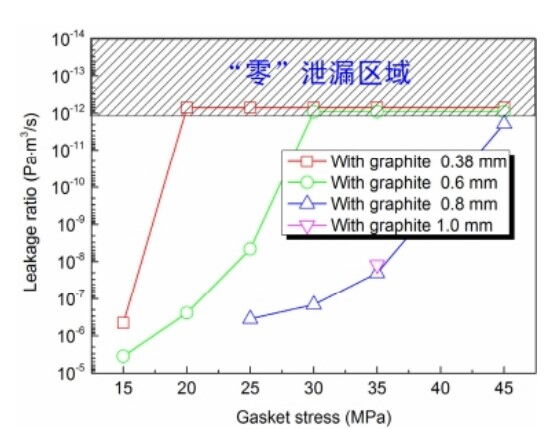
Figure 1.10: Variation of Leakage Rate of Composite Gaskets with Different Graphite Thicknesses with Gasket Sealing Specific Pressure
Figure 1.11 shows the comparison of leakage rates of composite gaskets with different graphite cover layer thicknesses under two different sealing specific pressures. It can be clearly seen from the figure that the leakage rate of composite gaskets with smaller graphite cover layer thickness (0.38mm/0.6mm) is much lower than that of gaskets with thicker graphite cover layer thickness; the composite gasket with 0.8mm graphite cover layer has the highest leakage rate, while the composite gasket with 0.38mm graphite cover layer has the lowest leakage rate.

Figure 1.11: Effect of Graphite Cover Layer Thickness on Leakage Rate
From the perspective of stress relaxation: the composite gasket with 0.6mm graphite cover layer thickness has the smallest relaxation rate, which is only 3.94%, see Figure 1.12 and Figure 1.13; contrary to the leakage rate, the composite gasket with 0.38mm graphite cover layer thickness has a higher relaxation rate than that with 0.6mm; and with the increase of graphite cover layer thickness to 0.8mm or 1.0mm, the relaxation rate will further increase.
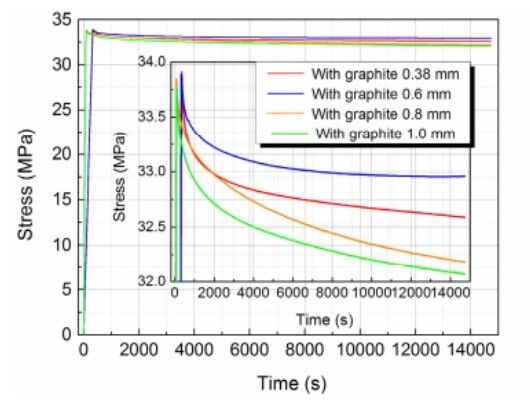
Figure 1.12: Stress Relaxation Curves of Composite Gaskets with Different Graphite Cover Layer Thicknesses
The reason for the above situation may be related to the degree to which the framework material exerts its reinforcing effect. Specifically: for the composite gasket with 0.38mm cover layer thickness, the cover layer thickness is small, and the graphite is almost completely squeezed into the grooves of the 316L corrugated plate, but the graphite squeezed into the grooves cannot completely fill the grooves in a compacted state before the corrugated plate undergoes large plastic deformation. At this time, when subjected to gasket stress, the density of the graphite in the grooves will continue to increase with the plastic deformation of the corrugated plate. However, when the graphite cover layer is thick enough, as the gasket stress increases, the grooves of the corrugated plate are completely filled with graphite, and these compacted graphite are fully capable of resisting the corrugated plate from undergoing plastic deformation, thereby effectively enhancing the deformation of the composite gasket over time. Therefore, the relaxation rate of the composite gasket with 0.6mm cover layer thickness is significantly lower than that with 0.38mm cover layer thickness. However, if the graphite layer thickness continues to increase, then there will be excess graphite above the framework material, and at this time the reinforcing effect of the framework material will gradually weaken, and the graphite above the framework material will gradually flow radially in both directions, thereby increasing the relaxation rate of the composite gasket.
In summary, the thickness of the graphite layer of the composite gasket has a significant impact on whether the framework material can normally exert its reinforcing effect.
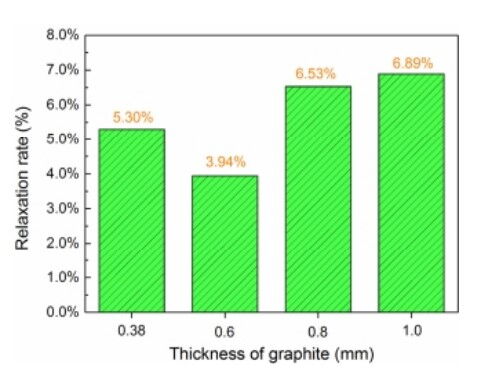
Figure 1.13: Stress Relaxation Rates of Composite Gaskets with Different Graphite Cover Layer Thicknesses
5. Influence of the Presence or Absence of Corrugations in the Framework Material on Gasket Sealing Performance
From the above analysis, it is known that the framework material of the composite gasket has a reinforcing effect on the sealing performance of the gasket, and the thickness of the graphite layer has an important impact on its ability to exert this reinforcing effect.
Figure 1.14 shows the influence of the presence or absence of corrugations in the framework material on gasket leakage rate. It can be seen from the figure that under different sealing specific pressures, the leakage rate of the composite gasket with a 316L flat plate as the framework material is much higher than that of the corrugated enhanced composite gasket. That is to say, the 316L metal corrugated plate as the framework material can effectively improve the sealing performance of the composite gasket.
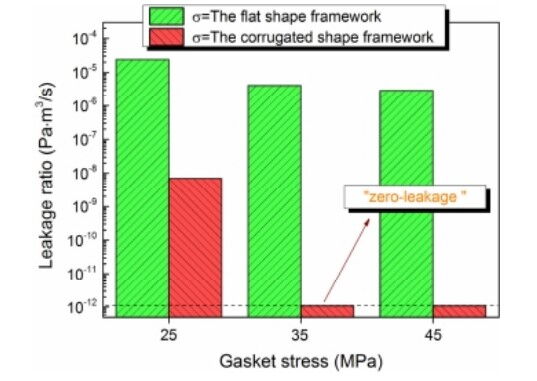
Figure 1.14: Comparison of Leakage Rates of 316L Flat Plate/Corrugated Gaskets under Different Gasket Stresses: Graphite Cover Layer Thickness 0.6mm
Figure 1.15 shows the stress-strain curves of composite gaskets with different framework material structures (flat plate/corrugated plate) under different sealing specific pressures. It can be seen from the figure that compared with the flat plate framework material, the composite gasket enhanced by the 316L corrugated plate has a larger strain to reach the predetermined sealing specific pressure. In addition, the stress-strain curve of the composite gasket with flat plate framework material is smooth during the compression process, while the stress-strain curve of the corrugated enhanced composite gasket fluctuates significantly in the 5-10MPa sealing specific pressure stage. The specific reasons have been analyzed above.
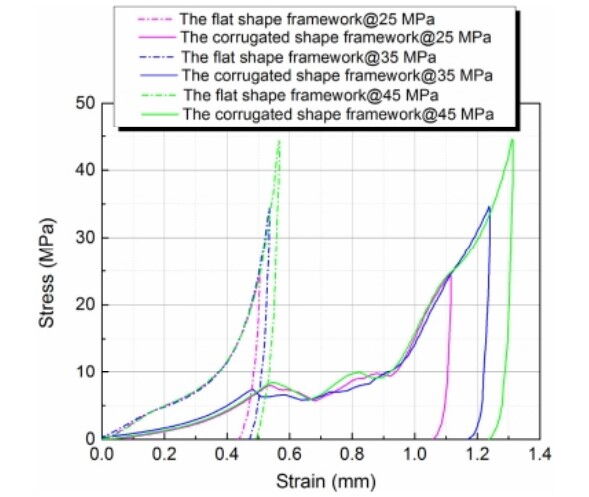
Figure 1.15: Stress-Strain Curves of Flexible Graphite Covered (0.6mm) 316L Flat Plate/Corrugated Gaskets
Figure 1.16 shows the comparison of rebound rates of 316L flat plate/corrugated gaskets under different gasket stresses. It can be seen from the figure that for the composite gasket with flat plate framework material, its rebound rate gradually decreases with the increase of gasket sealing specific pressure; the rebound rate of the 316L corrugated plate enhanced composite gasket gradually increases with the increase of gasket sealing specific pressure.
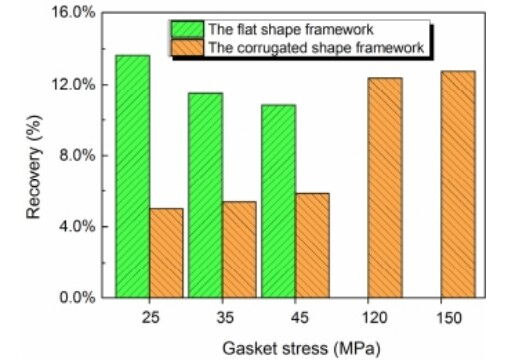
Figure 1.16: Comparison of Rebound Rates of 316L Flat Plate/Corrugated Gaskets under Different Gasket Stresses: Graphite Cover Layer Thickness 0.6mm
On the other hand, although it can be seen from Figure 1.16 that the rebound rate of the composite gasket with flat plate framework material is higher than that of the 316L corrugated plate enhanced composite gasket, due to the different degrees of deformation of the two gaskets during compression, the actual absolute rebound amounts are close (see Table 1.1). For the 316L corrugated plate enhanced composite gasket, its rebound amount increases significantly with the increase of sealing specific pressure. For example, the rebound rate of the 316L corrugated plate enhanced composite gasket can be close to 13% under a gasket sealing specific pressure of 150MPa, and the absolute rebound amount is 18.65µm. This data fully shows that the gasket still has good rebound characteristics under excessive gasket stress, which means that it can effectively prevent bolt relaxation to a great extent.
|
Sealing Type |
25 MPa |
35 MPa |
45 MPa |
120 MPa |
150 MPa |
|
SS 316L Flat Plate |
6.73 |
6.38 |
5.68 |
||
|
SS 316L Corrugated |
5.42 |
6.91 |
7.60 |
17.08 |
18.65 |
Table 1.1 Comparison of Absolute Rebound Amounts of Flexible Graphite Covered (0.6mm) 316L Flat Plate/Corrugated Gaskets (µm)
Figure 1.17 shows the initial height and residual thickness changes of the gasket and framework material before and after compression/rebound test of composite gaskets with different graphite layer thicknesses and a sealing specific pressure of 45MPa. It can be seen from the figure that with the increase of graphite layer thickness, the residual total height of the composite gasket after compression/rebound test shows an upward trend; while the residual height of the 316L metal corrugated plate shows an upward trend first and then gradually tends to be stable. Compared with the composite gasket with 0.8mm graphite cover layer, the graphite layer above the corrugated plate reinforcement layer of the composite gasket with 1.0mm is thicker. This is also the main reason why this type of gasket has high leakage rate and serious stress relaxation.
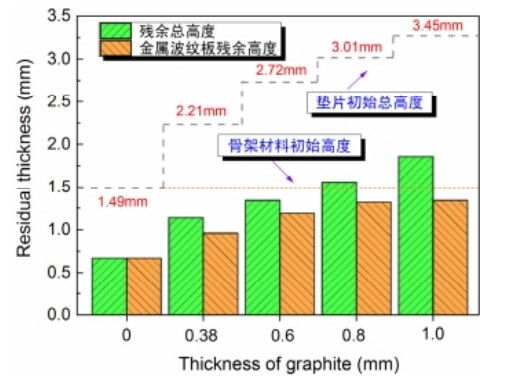
Figure 1.17: Initial Height and Residual Thickness Analysis of Gasket and Framework Material with Different Graphite Thicknesses: Gasket Stress 45MPa
Figure 1.18 shows the initial height and residual thickness changes of the gasket and framework material before and after compression/rebound test of composite gaskets with different sealing specific pressures and a graphite layer thickness of 0.6mm. It can be seen from the figure that with the increase of sealing specific pressure, the residual total height of the composite gasket after compression/rebound test shows a downward trend and quickly tends to be stable; while the residual height evolution of the 316L metal corrugated plate also shows a similar trend.
At the same time, it can also be seen from the figure that the graphite layer can effectively resist the deformation of the framework material. For example, under a sealing specific pressure of 150MPa, the residual height of the 316L metal corrugated plate is still close to 1mm.
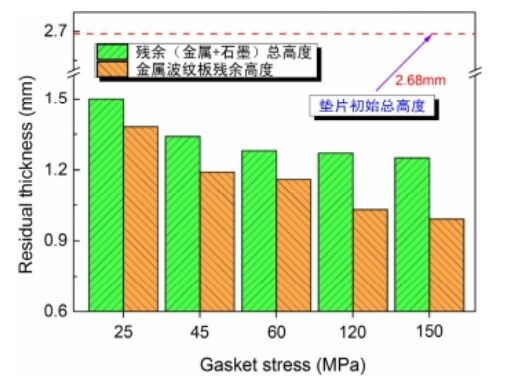
Figure 1.18: Comparison of Initial Height and Residual Thickness of Gasket and Framework Material under Different Gasket Stresses: Graphite Thickness 0.6mm
1. The thickness of the graphite layer on the composite gasket has an important impact on the sealing performance of the gasket. Through the comparative analysis of compression/rebound, leakage rate, stress relaxation and other tests, it is known that for this type of composite gasket reinforced with 316L metal corrugated plate framework material (specific size and structure see Figure 1.1), the graphite cover layer of 0.6mm has better comprehensive sealing performance;
2. By comparing the two different composite gaskets with flat plate/metal corrugated plate framework materials, it is found that the use of metal corrugated enhanced framework material can significantly improve the sealing performance of the composite gasket;
3. It is found that the initial sealing specific pressure of this type of gasket is around 30MPa, and even under higher sealing specific pressures (such as 150MPa), the composite gasket can still prevent the framework material from undergoing large plastic deformation, and its rebound performance is excellent under high sealing specific pressures. Therefore, for this type of flexible graphite covered metal corrugated enhanced composite gasket, it is recommended to appropriately increase the sealing specific pressure in on-site use.